Cover image: Reap What Is Sown by Cynthia Sheppard
My wife and I were on our way from North to South Dakota, via US Route 85. She was working on her laptop in the passenger seat, and I had over 100 miles of arrow-straight road to look at. It was summer, but the sun was hiding behind a canopy of clouds. I looked around, and started to notice the things that are missed when flying over these spaces. There are slow, rolling hills that give you peeks at trees over ten miles away. There are rocky outcroppings that climb up in the distance, breaking the profile of the horizon. There are streams that meander through the waist-high grass, with herds of cows scattered around.
This got me thinking about life on the plains, and how it’s depicted in the fantasy media we consume. These spaces have long been utilized in Magic’s visual history, telling the stories of farmers, villages, religion, warfare, and life under a big sky. And so today we step out into the great wide open and look at life on the plains.
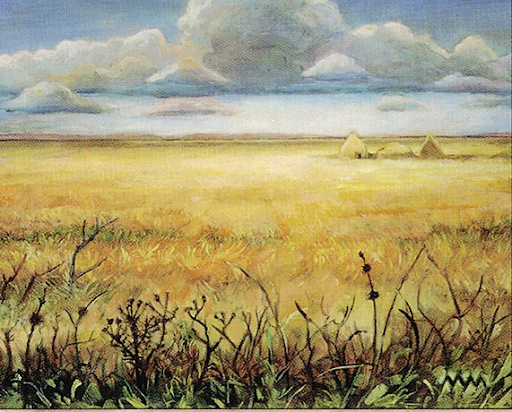
Plains by Matthew Mitchell
Understanding the Space
A plains is generally defined as an expanse of land that doesn’t change much in elevation, with few trees. They can be formed in various ways, such as deposits of sediment from thawing ice or wind. They could also come from lava flows, or through the erosion of larger land features over time. These spaces represent both the creation of something new, or the remnants of what’s left. That can be reflected in the people and civilizations that inhabit them.
The plains is a setting for the story, shaping the narrative we see play out in the cards. Some sets feature knights riding through warm, golden wheat. Others might show the plains clinging to life, after war has ravaged the landscape. The plains is a wide canvas to learn the story of a Magic set. Our various Magic civilizations tend to fall in three categories: nomadic groups, agrarian villages, and sprawling nation-states.
Nomadic Groups
These are civilizations deeply connected to the plains. A nomad doesn’t choose one corner to settle in, rather their home stretches until the horizon. Their settlements can move around the landscape; dictated by seasons, migratory animals, warfare, or other political forces.
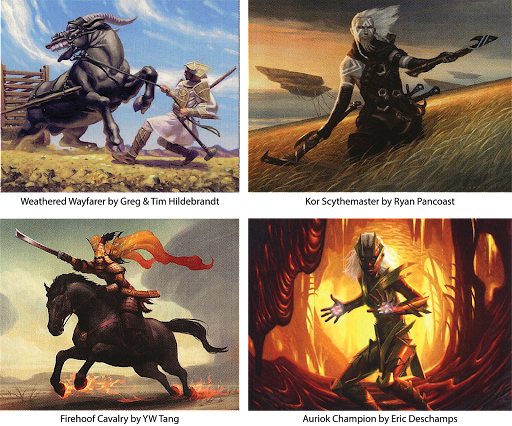
Visually, nomadic groups are often shown as embodiments of the lands they traverse. The nomads of the Daru Plains, found in Onslaught and Odyssey, wear light armor of dried, tightly-bound Otarian high grass. It’s meant to be lightweight, giving them mobility to respond quickly to movement along the plains. Meanwhile, the Auriok of Mirrodin wear armor that links them to the Razor Fields. By adapting to the environment around them, they can blend in with the metallic blades that blanket the landscape.
When it comes to visual storytelling, correct portrayal of nomads is important. In some western media, nomad groups have been portrayed as savage or uncivilized. But, it’s worth remembering that civilized people don’t need cities to live in. Consider the Mardu of Tarkir: based on the Mongol Empire of the 13th and 14th centuries, they depict a nomadic nation of warriors, like those shown in Firehoof Cavalry. When it comes to portrayal, there is more to the Mardu than raids or flying arrows. Characters like Alesha, Who Smiles at Death bring dramatic complexity to their story, while the divergent fates of Zurgo Helmsmasher and Zurgo Bellstriker bring humor to the endless battles of Tarkir.
Agrarian Villages
The plains are a home for wheat to grow and cows to graze. With this comes communities of farmers that till the land. Food has to come from somewhere, so most sets will feature farmers in some capacity.
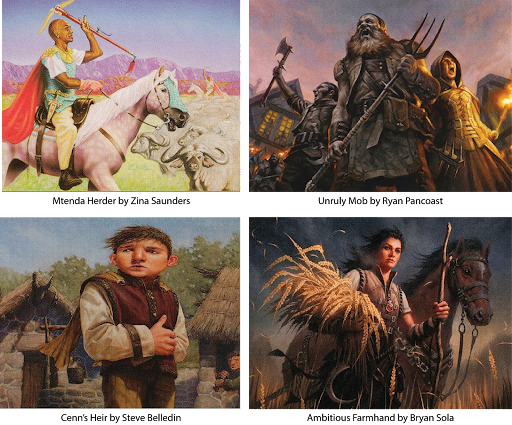
In Lorwyn, Kithkin tend to springjacks on emerald green hills. They were inspired from Celtic folklore, wearing earth tone clothing and living in thatch roof cottages. Their modest communities contrasted the more mystical creatures like merfolk, faeries, or goblins. But their community wasn’t without its secrets, such as the Thoughtweft, a hive mind ability that bound all Kithkin together.
A farming community can be a foundation for hiding secrets. Innistrad shows us that secrets can hide behind closed doors, or inside the villagers themselves. By day, the townsfolk go about their usual tasks. By night, they take a different turn. Unruly Mob shows us how an idea stirs people into action, especially when it’s a threat hidden just outside the torchlight. But even after you turn in from a night chasing werewolves, you might wake to the Village Cannibals.
At face value, a village of farmers on the plains look to be just that. But Magic has shown us that a farming community can tell stories when they cast their tools aside for something else.
Sprawling Nation-States
On the largest end of scale, we have the nation-states. These are the civilizations that stretch across a continent, shaping the larger power struggles in a set. It’s worth recognizing that these groups aren’t confined solely to the plains, but rather the plains play a part in their story.
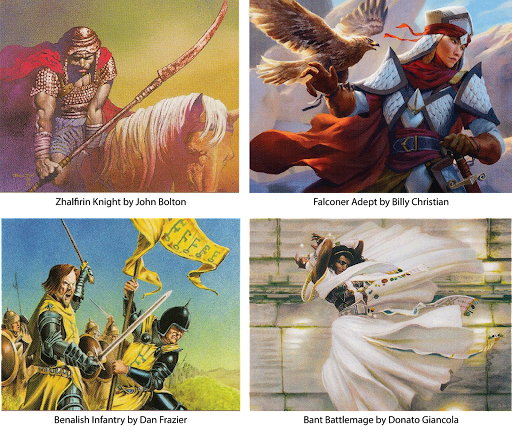
The kingdom Zhalfir can help illustrate how the plains aid the nation as a whole. The Mtenda Plains are one part of a larger realm, bringing food and livestock, as well as the occasional griffin attack. There might be several towns spread across the landscape, with cards like Mtenda Herder representing the people who live there.
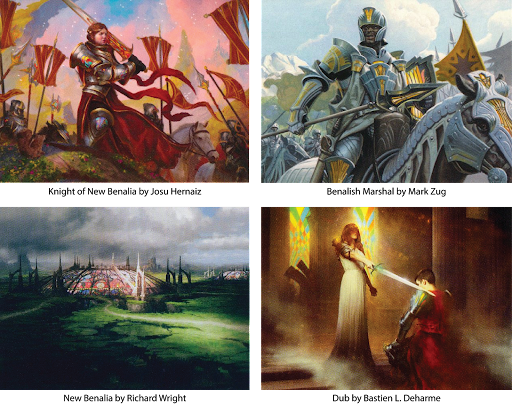
Benalia is one of the most frequent depictions of a nation state on the plains. Stretching all the way back to Alpha, they borrow elements from European fantasy: knights in shining armor, stone castles rising from the hills, and stained glass windows. We can draw lines between the Benalish and Athurian legend, or the Greyhawk setting of Dungeons & Dragons. This is a country who sees the plains as property. The grasslands are theirs to farm, travel, and send armies across.
The larger a nation grows, the less it fears the land around them. This mindset can come from the ways in which they’ve mastered their landscape. If you’re in the Abzan Houses, the plains are a lot less imposing from atop a Siege Rhino. To a nation state, the plains is part of a map, spread across a general’s table. It’s a space to use as a tool, and to protect from others.
Farmer to Soldier, and Back Again
The humble nature of working in the plains provides a backdrop for unlikely heroes. We see that in the Seventh Edition version of Eager Cadet, as a farmer rushes off to join the fight. You could say they’re leaving everything in a hurry, but the flavor text tells us that there isn’t much left to return to. The threat is on their doorstep, and the choice to fight seems to be made for them. Armies travel fast on the plains, so there isn’t much time for decision making. In Path to Peace from Portal Second Age, we see the opposite. Farming is taken up as a retreat from warfare, with weapons collecting cobwebs. They might have gone from shedding blood in the snow to cultivating life in the Spring.
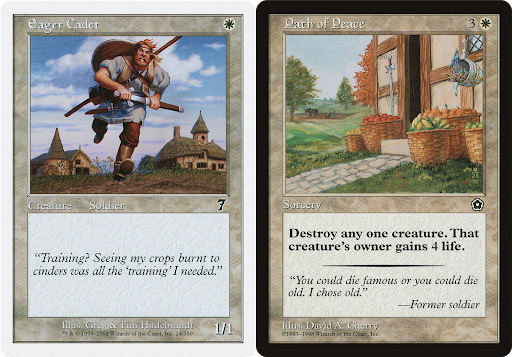
The concept of farming stands directly opposite to soldiering. In the Bible, Isaiah 2:4 reads, “…and they shall beat their swords into plowshares, and their spears into pruning hooks; nation shall not lift up sword against nation, neither shall they learn war anymore.” Tools of war find new life as tools for peace. Outside of the United Nations, this verse takes the form of a sculpture by the Soviet sculptor, Yevgeny Vuchetich. This provides context for Swords to Plowshares, first painted for Magic by Jeff Menges. For 28 years, this spell has been making creatures cast down their weapons and leave the battlefield for good. Or if we’re talking about Birds of Paradise, “STP” sends them to a nice little farm upstate.
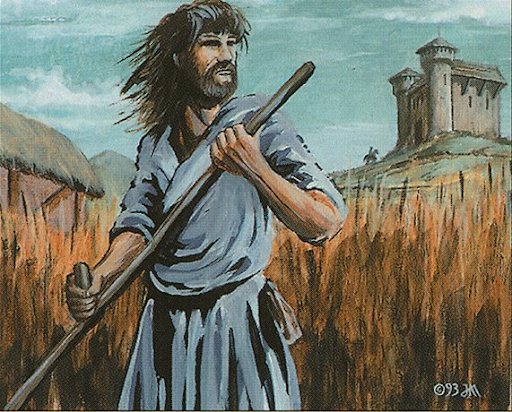
Swords to Plowshares by Jeff Menges
Mysticism Under the Big Sky
For those living out on the plains, religion can come in a variety of forms. Polytheism is common in Magic storytelling, with followers worshipping a variety of deities. For someone out on the plains, it’s not unusual to worship deities that represent life, the sun, and the harvest. Good will from these spirits means good weather and a full table.
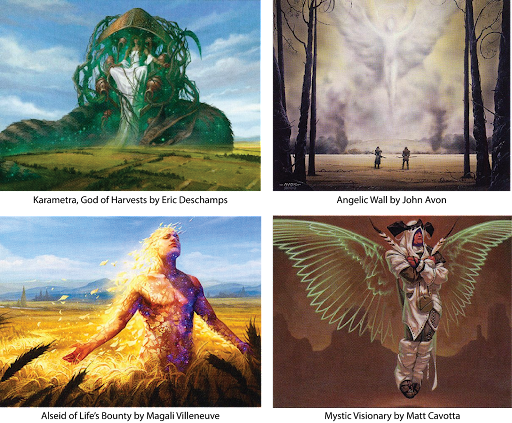
For the plane of Theros, one might turn to Karametra, God of Harvests. She represents a large-scale influence on the world itself, similar to Demeter in Greek mythology. Meanwhile, their fields might be visited by an Alseid of Life’s Bounty, a nymph of glens and groves.
Religion varies in scope from one world to another. Some feature deities mingling with mortals out on the plains, while others take a more indirect approach. In Onslaught and Odyssey blocks, the Daru worshipped The Ancestor, a being they attributed to creating all life on Otaria. Their clerics described an angelic being, watching from the skies above the plains. The Ancestors presence can be seen in various forms, whether it be an apparition like Angelic Wall, or the energy passing through Mystic Visionary.
When Dominaria was released in 2018, it was revealed that The Ancestor was a form of Serra, the Benevolent. Daru clerics, far below the Serra’s Sanctum, may have seen Serra Angels as agents of a god, instead of a planeswalker that traveled the multiverse.
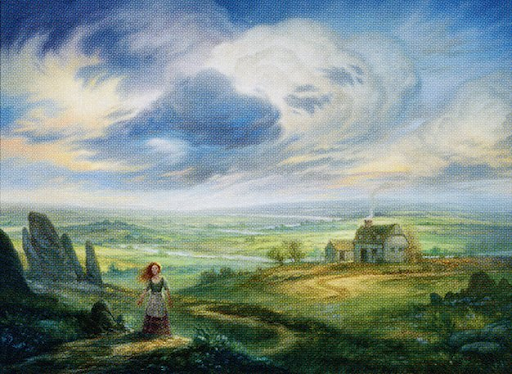
Idyllic Grange by Howard Lyon
Being Comfortable With Being Small
As I drove through South Dakota, I couldn’t help but feel small. I could roll the windows down, blast music, and honk our horn, but that all gets lost to the wind. The plains don’t need mountains towering above to remind us of our insignificance. All they need to do is show a horizon that is always just beyond our reach.
When looking through the lens of a Magic card, the plains are quiet and unassuming. Their muted browns and yellows provide a foundation for the more colorful aspects of a set. They ground an imaginative game in a sense of realism, a foundation for us to look at griffins, angels, and the occasional Master Decoy.
People find different reasons to come to the plains, but they do share a similar experience. The days are long, the weather can be harsh, but they know that the plains cultivate life. Civilizations grow like fresh crops in the Spring, as some seek to dominate the landscape. But they can just as easily disappear below the high grass, and out of the memory of those that inhabit it.
Cities rise, cities fall, and the grass keeps blowing in the wind.
Travis is a writer and photographer from the Hudson Valley in New York. He’s currently traveling the US with his wife and dog, living full-time out of a converted camper van. He has loved Magic since Starter 1999, but he champions having a healthy mental and financial relationship with the game. When not playing games, he enjoys cycling, tea, and dog parks. You can follow his exploits here on Twitter and Instagram.

